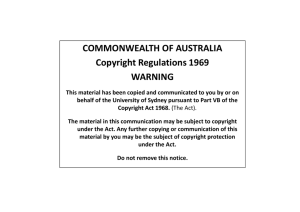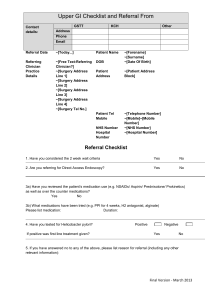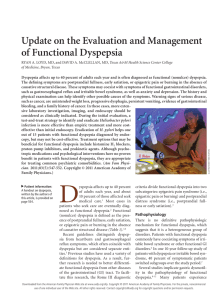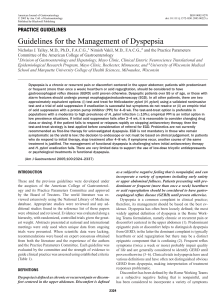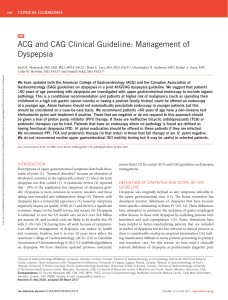Abandoning the Silos: An Integrated Approach to Pharmacy Education
advertisement
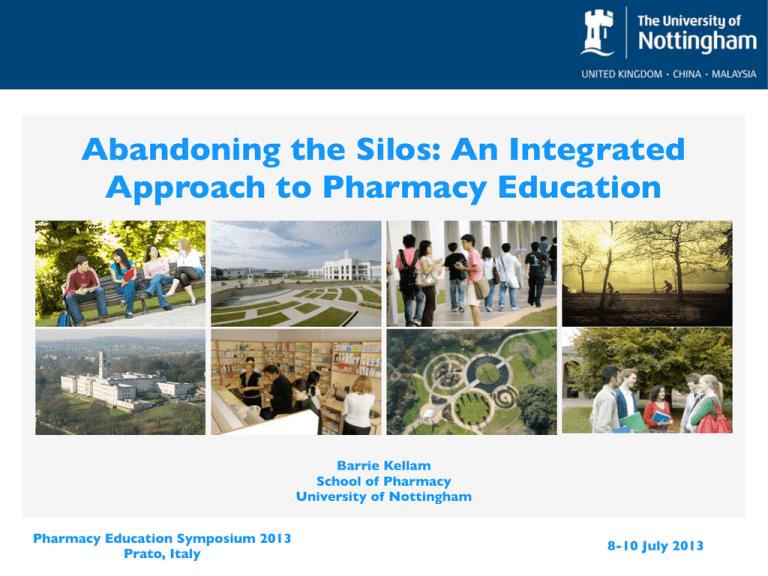
Abandoning the Silos: An Integrated Approach to Pharmacy Education Barrie Kellam School of Pharmacy University of Nottingham Pharmacy Education Symposium 2013 Prato, Italy 8-10 July 2013 Initial education and training of pharmacists Initial education and training of pharmacists Competent MPharm Proficient Pre-Reg Expert Career The Nottingham Graduate: A Stakeholder's Perspective Skills and Attitudes Good theoretical knowledge but often don’t apply it well. Students need to use initiative and judgement; not too risk-adverse, but aware of consequences of actions (or inaction). A need to appreciate the wider picture. Attention to detail good and must remain. Need to instill sense of personal and professional responsibility and pride. Knowledge of and attitudes towards others in the pharmacy team. The Nottingham Experience: A Stakeholder's Perspective Ethos of the Course Don't be too focussed on the ‘right’ answer. There may not be one. Think about how decisions are made (not just whether it was the correct decision). Don’t let over-cautiousness outweigh caring and commitment. Challenge where appropriate. Questioning and curiosity. Be patient-focussed rather than disease focussed. Be aware of considerations other than just clinical (economic, business, political etc.). The Pharmacist: A True Multidisciplinarian The Drug The Medicine The Patient MPharm Course Overview Vertical Theme Integration Curriculum must be progressive (the spiral curriculum). Deal with issues in an increasingly complex way until the right level of understanding is attained. Provide opportunity for continuous contextualised exposure Level 2 Plan Dr Colin Dr Charlie Dr Sue Prof Claire Vertical Theme Integration MPharm 2012: Dyspepsia (B31DYS) Summary of the vertical themes Pharmacology & Therapeutics Biology & Physiology Pharmaceutics Diseases and Symptoms • Causes of ‘chest pain’ • The process of peptic ulceration • Drug (especially NSAID) induced ulceration • ANAEMIAs and full blood counts • Gastro oesophageal reflux disease • Evidence for the role of diet, lifestyle, environmental factors Targets • H2 receptors • Proton pumps • G proteins and second messenger systems • Membranes • Steroids – signpost only • Arachidonic acid metabolism Therapeutic Classes and Drug Examples • Antacids • PPIs • H2RAs • Misoprostol • Prokinetic drugs • Antibiotics signpost only • Immunological tests for H. pylori infection • NICE guidance • Relevant drug interactions and pharmacokinetics Anatomy and Function of the Human Body Structure & function of the stomach & GI tract Physiology/biology of parietal cells Digestion Epithelial membrane /epithelial cells Autonomic nervous system Cell Biology Introduction to bacterial infections Microbiology of Helicobacter pylori infection Proteins enzymes, role in membrane transport, and drug targets Physical and Chemical Properties Relevant to Formulation Solubility and solutions Suspensions pH and its impact on solubility, partition and buffering The Henderson Hasselbalch equation (link to chemistry) Buffers (also as type of antacid medicine) Basic polymer properties (polymer characterisation, solubility, swelling & viscosity/rheology) Solution properties of polymers Formulation Design and Manufacture of Medicines Powders and suspension dosage forms Rafting agents Oral solutions Enteric tablet coating: polymer and pH effects Practical Pharmaceutics Formulation of antacid powders and suspensions for testing in chemistry practicals Chemistry Absorption, Distribution, Metabolism and Elimination Mechanism of Drug Absorption Action Local and systemic Antacids effects of drugs (e.g. antacids vs PPIs) Raft forming agents Acid/base effects, Antiflatulants buffers, ionisation, pH PPIs partition, diffusion Fundamental Concepts partition theory, lipid Further molecular permeability, drug structure, functional solubility and salts. groups, nomenclature, Inhibition of gastric stereochemistry & acid secretion – effect molecular properties on absorption of Introduction to other drugs. simple heterocycles Gastric emptying (including histamine times. & H2RA) and naming Acid compartment Physical Chemistry & trapping (PPIs) Analysis Metabolism Acid base chemistry Cyt P450 early Fundamental acid introduction to base chemistry; primary metabolic including dyspepsia transforms. based material Cyt P450 inhibition Buffers (ranitidine vs pH and solubility cimetidine; complex Mass spectrometry (MS) 13 effects of omeprazole C urea breath test on Cyt P450). for H. pylori Chemical Mechanisms Protonation of heteroatoms Mechanism of ester hydrolysis (intro ductory treatment) Practical Chemistry Analysis of antacids (including those produced by students), raft forming agents and anti foaming agents Clinical and Pharmacy Practice Responding to symp toms of dyspepsia Differential diagnosis Health promotion advice with dyspepsia. Role of diet & lifestyle in causing/aggravating /alleviating symptoms OTC product selection e.g. symptoms, other conditions, drug interactions, choice of products type (drug and formulation), special patient groups (infants reflux) Giving advice with OTC and dispensed medicines OTC – treatment of dyspepsia including distinguishing dyspepsia and MI When to refer and speed of referral Antacids, raft forming agents, H2RAs, PPIs, Prostaglandin analogues, prokinetic drugs, antibiotics Symptoms in the mouth – e.g. ulcers, gingivitis NICE guidance on triple therapy Professionalism and Leadership Personal Development and Professionalism Communication skills Reinforcement of calculations Reinforcement of CPD opportunities Start of reflective portfolio (and link to placements) Placements – link to module through activities in pharmacies Independent learning/working independently Collaborative learning/working in teams Reading scientific /technical texts Laboratory report writing Scientific enquiry / problem solving Pharmacist as public understanding of science expert Law, Ethics and Dispensing Practical dispensing of dyspepsia related products GSL, P and POM Labelling requirements Decision making: product selection; use of drugs in pregnancy Case Studies: A Hybrid PBL Students will encounter about 25 Case Studies. Each Case Study begins with the description by a patient of their symptoms. This initiates a series of on-line videos or text based scenarios that students consider in small groups. As the Case Study progresses over the week, the clinical and scientific content becomes more complex providing excellent examples of how science underpins the clinical interventions of the pharmacist. Each Case Study is embedded in a DMP with lectures providing some of the information required. Students work through and debate Case Studies in small groups with staff acting as facilitators of discussions. In Year 4, Case Studies increase in complexity with 10 examples being explored across the year and students playing Case Studies Case Studies Case Studies Case Studies Case Studies Case Studies Case Studies Case Studies Case Studies Case Studies Case Studies The student & staff experiences so far • MPharm I students extremely receptive to and positive about the case study experiences. • The use of iPads as a delivery medium was very popular. • Staff time is significant. • Some mixed experiences with different staff members. • Need to be cognisant of the “Speedy Gonzales”. • Need to deal with the domineering student/personality clashes • Need to deal with students taking shortcuts • Review is critical
